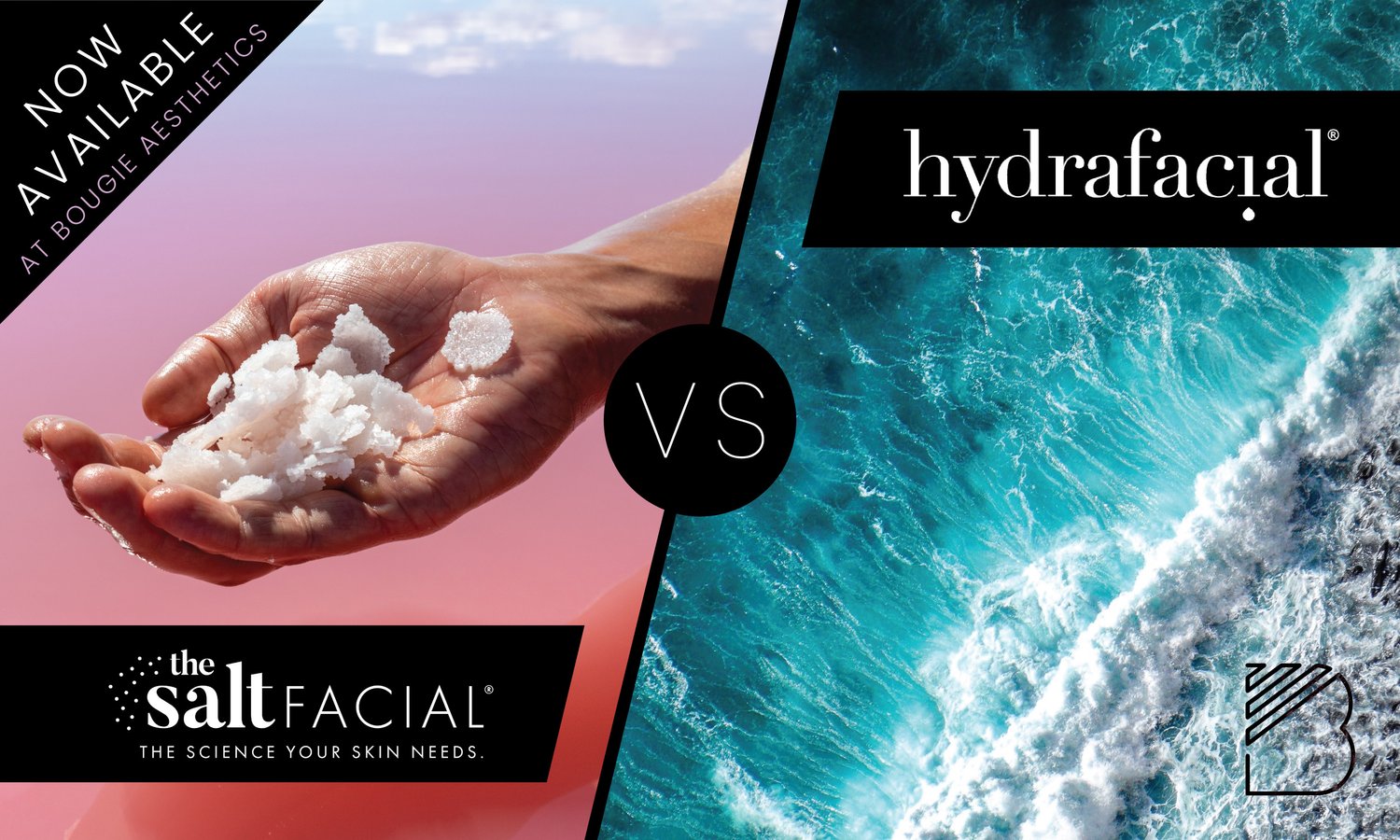This Site Is A Participant In The Amazon Services LLC Associates Program. We may earn money or products from Amazon or the companies mentioned in this post.
A salt facial exfoliates the skin using salt crystals, while a hydrafacial uses a patented system to cleanse, extract, and hydrate the skin. Salt facials provide a deep exfoliation, removing dead skin cells and promoting skin regeneration.
Hydrafacials, on the other hand, offer a comprehensive treatment that cleanses, exfoliates, extracts impurities, and hydrates the skin through a vortex suction system with customized serums. Both treatments have their unique benefits, so choosing between them depends on individual skin concerns and goals.

Credit: www.bougieaesthetics.net
Key Differences Between Salt Facial And Hydrafacial
Salt facial and hydrafacial are two popular treatments with distinct objectives. Salt facial is a gentle exfoliating treatment that aims to remove dead skin cells and unclog pores. It utilizes salt crystals to slough off the outermost layer of the skin, revealing a brighter and smoother complexion.
On the other hand, hydrafacial is a hydrating and rejuvenating treatment. It involves a series of steps, including cleansing, exfoliating, extracting impurities, and hydrating the skin with serums. The primary objective of a salt facial is to exfoliate the skin, whereas a hydrafacial focuses on hydrating and rejuvenating the skin.
Both treatments offer unique benefits and can be tailored to individual skincare needs. Choosing between the two depends on your specific skin concerns and desired outcomes.
Comparison Of Benefits And Results
Deeply exfoliating to eliminate dead cells and rejuvenating cell turnover, the salt facial offers improved texture and tone, while the hydrafacial hydrates and nourishes the skin, targeting specific concerns like wrinkles. Experience a radiant and youthful appearance.
Treatment Process And Techniques
Salt facial and hydrafacial are two popular treatments with different processes. The salt facial starts with an application of a salt-based exfoliating scrub to remove dead skin cells. A gentle massage follows to stimulate circulation. Once the scrub is removed, a moisturizer is applied to hydrate the skin.
On the other hand, the hydrafacial involves cleansing and exfoliation using a specialized tool. Impurities and debris are then extracted from the pores, leaving the skin clean. The final step includes the application of customized serums to nourish and hydrate the skin.
Both treatments offer unique benefits, so it’s essential to choose the one that suits your skin needs the best.
Safety Profiles And Side Effects
Salt facial is generally safe for all skin types, with only possible temporary redness or irritation. Some individuals may experience mild discomfort during the exfoliation process. On the other hand, hydrafacial is suitable for all skin types, with minimal risk of side effects or skin irritation.
It does not require any downtime or recovery period. Both treatments offer safety profiles with minimal risks involved. However, each procedure may have different experiences or sensations during the process. It is important to consult with a skincare professional to determine which facial treatment is suitable for your specific skin type and concerns.
Cost And Frequency Of Treatment
Salt facials and hydrafacials vary in terms of cost and frequency of treatment. The average cost for a salt facial session is reasonable, making it an affordable option for many. To achieve optimal results, it is recommended to undergo salt facials regularly.
In comparison, hydrafacial sessions tend to be slightly costlier. However, the investment is worthwhile as hydrafacials provide excellent outcomes. For the best results, consistency is key, with regular hydrafacial treatments being recommended. Whether you opt for a salt facial or a hydrafacial, maintaining a consistent frequency of treatment is essential to achieve and sustain the desired outcomes.
Which Treatment Is Right For You?
When choosing between salt facial and hydrafacial, it’s important to consider certain factors. The first step is to consult with a skincare professional who can provide personalized recommendations based on your specific needs and goals. They will assess your skin type, concerns, and desired outcome to determine which treatment is right for you.
Factors to consider include the level of hydration your skin needs, the depth of exfoliation required, and any specific skin conditions or sensitivities you may have. By understanding these factors and discussing them with a skincare professional, you can make an informed decision about whether a salt facial or hydrafacial is the best choice for your skincare regimen.
Frequently Asked Questions Of Salt Facial Vs Hydrafacial
Is A Salt Facial Worth It?
Yes, a salt facial is worth it. The salt helps exfoliate dead skin cells, leaving you with a fresh and smooth complexion. It also helps cleanse your pores, reducing the appearance of blackheads and whiteheads. In addition, salt facials can enhance blood circulation, promoting a healthy glow.
The minerals present in the salt can also nourish and hydrate your skin, giving it a youthful appearance. It is a natural and gentle way to rejuvenate your skin without harsh chemicals. Regular salt facials can improve the texture and tone of your skin, making it look more radiant and vibrant.
Overall, a salt facial is a beneficial treatment for those looking to improve their skin’s health and appearance.
What Is Better Facial Or Hydrafacial?
Facial and hydrafacial are both beneficial for the skin. Regular facials involve cleansing, exfoliating, and nourishing the skin, improving texture and appearance. Hydrafacial is a more advanced treatment that uses a multi-step process to cleanse, extract, and hydrate the skin.
It is effective in reducing fine lines, wrinkles, and improving skin tone. The main difference between the two lies in the technique used and the depth of treatment. While regular facials can be customized based on the individual’s skin needs, hydrafacial offers a more comprehensive and deeper cleanse.
Hydrafacial is also suitable for all skin types, including sensitive skin. Ultimately, the choice between a regular facial and hydrafacial depends on your specific skin concerns and preferences. If you desire a thorough and deep cleansing experience that targets specific skin issues, hydrafacial may be the better option.
However, it’s always best to consult with a skincare professional to determine which treatment would suit you best.
What Does A Saltfacial Do?
The saltfacial is a rejuvenating treatment that uses a unique combination of sea salt, ultrasound, and high-frequency technology to exfoliate, rejuvenate, and nourish the skin. The sea salt crystals gently remove dead skin cells, leaving the skin smoother and more radiant.
The ultrasound technology stimulates collagen production and enhances the absorption of the nourishing serums applied during the treatment. Additionally, the high-frequency technology kills bacteria and reduces inflammation, making it ideal for those with acne-prone or sensitive skin. The saltfacial can improve skin texture, tone, and elasticity, reduce fine lines and wrinkles, and clarify and brighten the complexion.
It is a non-invasive, painless, and customizable treatment that can be tailored to individual skincare needs. Whether you want to address aging skin, acne, hyperpigmentation, or simply achieve a healthier glow, the saltfacial can help you achieve your skincare goals.
How Often Should You Get A Salt Facial?
A salt facial should be done once every 4-6 weeks for optimal results.
Conclusion
In this blog post, we explored the differences between a salt facial and hydrafacial. Both treatments offer unique benefits for the skin, but it ultimately depends on your specific needs and preferences. The salt facial is a natural and gentle exfoliation method that promotes detoxification and rejuvenation.
It can effectively remove dead skin cells, unclog pores, and promote a smoother complexion. On the other hand, a hydrafacial uses a combination of exfoliation, extraction, and hydration to deeply cleanse and nourish the skin. It is known for its ability to improve skin texture, reduce fine lines and wrinkles, and enhance overall skin health.
When deciding between the two, consider your goals and skin concerns. If you are looking for a more intensive and immediate result, a hydrafacial may be the better choice. However, if you prefer a more natural and gentle approach, a salt facial could be an excellent option.
Both salt facials and hydrafacials have their own unique benefits, and the decision ultimately comes down to what your skin needs and preferences are. Consult with a skincare professional to determine which treatment would be most suitable for you and enjoy the rejuvenating benefits it offers.

Amelia Varley is a professional beauty blogger and freelance writer with a passion for all things skincare, makeup, and holistic wellness. With years of experience in the beauty industry, Amelia shares expert tips, product reviews, and innovative beauty routines with her readers. Her writing is driven by a desire to empower people to look and feel their best through mindful beauty practices. When she’s not writing, Amelia enjoys experimenting with the latest beauty trends and exploring the connection between self-care and confidence.





